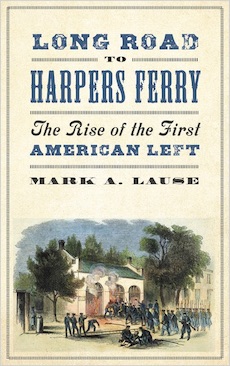By Louis J. Kern
This volume in the People’s History series provides a comprehensive overview of labor radicalism in ante-bellum America. Its focus is the collective organized efforts of ordinary working class men and women to combat the inequities and injustices of a privileged and unfettered capitalism.
Early chapters detail the betrayal of the democratic promises of the Revolution, specifically the fundamental principles of liberty, equality, and solidarity. In 1781 common soldiers of Pennsylvania and Massachusetts mutinied due to lack of supplies and non-payment. Many were defrauded of their land bonuses after the war. Only Pennsylvania, Vermont, and Georgia established governments designed to embody the will of the people. In the post-Revolution period, struggles over universal access to land sparked Shays’ (1786-87) and the Whiskey Rebellion (1794), seeking to counter growing inequities of wealth. These organized protests found eloquent expression in Thomas Paine’s Agrarian Justice (1797) aimed at “Meliorating the Condition of Man.”
In a sweeping survey of nineteenth century labor/land reform agitation ranging from the Land Act (1804) to John Brown’s raid on Harpers Ferry (1859), Lause considers the primary labor organizations like the National Reform Association (1844) and the National Industrial Congress (1846) as well as political arms—the Workingmen’s Party (1828-29) and the schismatic Democratic radicals—Locofocos (1835-37) and Barnburners (1842-48) that opposed banking monopoly, paper money, corporate abuses, and sought equal rights. Ultimately, labor/land reformers were absorbed into the Liberty Party (1840-48), Free Soil Party (1848-52), and the Republican Party.
Lause maintains that labor radicals deplored the ethnic cleansing of Native peoples, supported women’s rights, and early endorsed the abolition of slavery, but the evidence is scattered and unconvincing. He surveys utopian projects—Fourierist and Owenite communities—but finds them influential on radical thinkers but impractical, unlike Josiah Warren’s Modern Times (1851-64) and labor-based “Time Stores.”
The text moves at breakneck speed and introduces a bewildering multiplicity of names that often receive only a brief mention, few dates are provided, and the primary narrative thread is broken at points by marginally relevant asides. For example John Cleves Symmes and his fantastic, sci-fi Symzonia: A Voyage of Discovery (1820) that maintained that the earth was a habitable hollow sphere open at the Arctic pole. Alan Pinkerton makes an appearance as a labor champion and abolitionist, but there is no reference to his later brutal role in suppressing labor dissent.
George Henry Evans, former British Chartist and founder of the NRA, was a primary presence in the radical movement, but his activities and influences are scattered throughout the text making it difficult to assess his contributions. This is perhaps a conscious strategy to avoid elevating a single person to prominent leadership in order to highlight the collective movement.
Post-1848 radicals, chiefly Germans, brought socialism, communism, and a pragmatic political strategy to bear on labor protest and were more responsible than Lause admits for the accession of labor/land reformers to abolitionism. The NRA and George Lippard’s Brotherhood of the Union (1849 -) embraced anti-slavery, but Gerrit Smith was closer to the mark: “Radical Abolitionism, revolutionary émigrés, bohemians, land reformers and others generally shared a range of concerns, if not yet a common priority in those concerns.”
Lause makes the case for the contribution of collective resistance to the coming of the Civil War in a diffusive narrative that ironically may prove difficult for the general reader. His primary thesis may be more cogently followed in his Young America: Land, Labor, and the Republican Community (2005) that highlights the NRA, and A Secret Society History of the Civil War (2011) stressing the role of the Brotherhood of the Union.
Louis J. Kern (ΦBK, Clark University) is professor emeritus of history at Hofstra University. Hofstra University is home to the Omega of New York chapter of Phi Beta Kappa.




